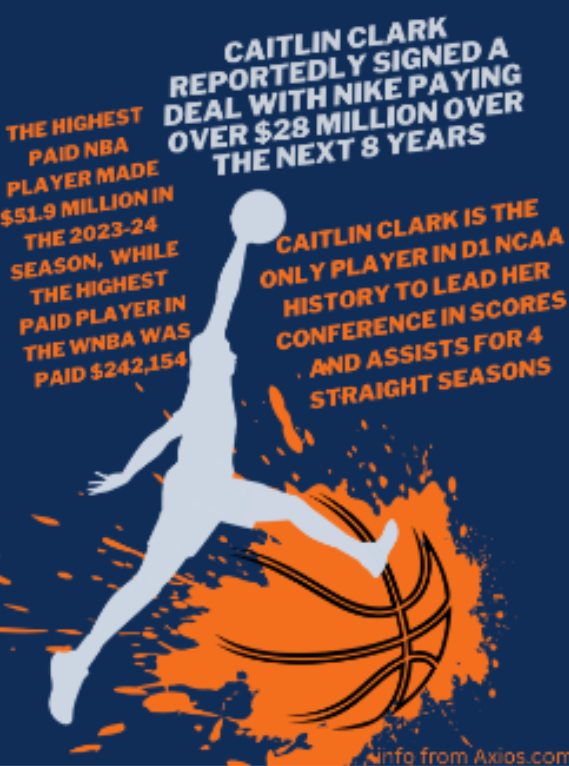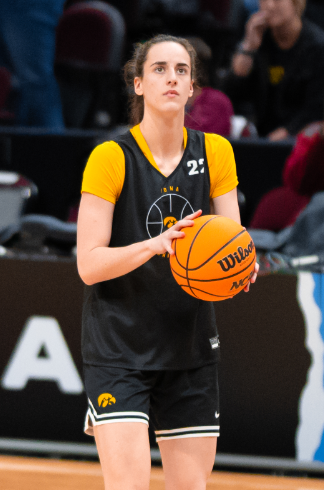Under the blinding lights of the arena, she moves with unmistakable prowess, a look of fierce competition in her eyes, two steps ahead in every play. With just a simple dribble step back maneuver, she forces space between herself and the defenders that can’t keep up. All eyes on her, the basketball superstar from Iowa, Caitlin Clark, bedazzles crowds time after time.
For the first time in all of March Madness history, the women’s championship drew a larger audience than the men’s game, at almost 19 million viewers. Clark’s later WNBA debut broke another record for highest watched WNBA game ever. Clearly, the viewers can’t get enough of her play, which is drawing more eyes on women’s basketball than ever before.
But what’s really so special about her, and why are more people watching women’s sports now than ever? Firstly, her popularity captures the essence of a trend gaining momentum for women’s sports: individual star players backed by a large, passionate audience. Audience investment requires the opportunity for individual stars to stand out, which then increases viewership because people are given someone to root for and care about. Other star players such as Angel Reece and Paige Bueckers have added to this, racking in viewers as people get invested in their individual stories. Clark’s unique gameplay and engaging personality has attracted a broader audience, leading to increased media coverage and greater investment back into women’s sports as people see the potential revenue.
This Caitlin Clark phenomenon is not lone-standing, just this year the Women’s Volleyball Championship, Nebraska vs. Omaha, drew 92,003 fans into the stadium, breaking the world record for the largest attendance at a women’s sporting event. And viewership numbers for many other women’s sports across the board favor this increase. As individual superstars skyrocket, new opportunities are offered to women, including increased media attention and celebrity deals which allow women to gain traction for themselves outside of the court. Though some new fans speculate the quality of play is rising, it is hard to discern if these women athletes are really getting better than those of the past, or if their rise in popularity is due to the new opportunities given by commercial investors and increased attention.
Historically, women in athletics have never gotten the chance to be equal. The media was against them and they were never seen as investable revenue streams. Since exposure to excellence opens pathways, how can women and girls be expected to succeed if they are never given the opportunity to showcase their abilities to a national audience? As proven by recent events, when they are properly advertised and televised they can generate huge amounts of money. In fact, tickets for the 2024 March Madness Women’s Final Four games sold at an average of $732, surpassing the men’s averaging at $710 a ticket. But in the past, preseason women’s games weren’t streamed, disallowing people to get as invested, and it wasn’t even until 2022 that women’s basketball was able to be called “March Madness.” Women’s sports were treated like a joke: the WNBA just got charter flights to their games, as of May 21, 2024, while NBA players have been enjoying that necessity for decades.
Sickeningly, many women athletes in the past have been forced to be sexualized for viewership, branded for sex appeal, which is just as problematic as dismissing their gameplay. Pioneers such as Billie Jean King, Simone Biles and Serena Williams were able to break away from this and create a path for those to come, but if women are to be able to get the same opportunities, they have to be given the same chance to make money, publicity and ads.
In previous years, any mention of tuning into womens’ basketball to a teenage boy around high school would be met with a scoff, or even a “who cares about women’s sports?” in a half-joking half-serious question. Though this has been disheartening as a female athlete, this past year something flipped. These same boys watched the NCAA women’s championship and talked excitedly about Caitlin Clark and her gameplay that rivals, if not outperforms, men’s, commenting on whether she will live up to her hype. The demographic for women’s sports is transitioning, transcending genders and generations as younger people recruit their parents to watch a star that they’ve seen on Tiktok or who was talked about at the lunch table. We’re entering a future era where one day, men who make it to the NBA can cite Caitlin Clark or another female athlete as their inspiration that they looked up to as little boys.
Shattering preconceived notions about the potential abilities of women extends to more than just sports. Sports are the secret backbone of the women’s movement for establishing the new normal, showcasing women’s competency under pressure, making it easier for men to envision women driving aircraft carriers, or participating in high pressure jobs dominated by men such as the military. Title IX is the closest to an Equal Rights Amendment that this country has ever seen.
While womens’ sports continue to gain traction, they are predicted to shape a different future. The next crop of stars will stand on the shoulders of those before them and open the door even more, so little girls watching at home who also hope to defy stereotypes to excel can be shown it is possible. Basketball has proven that if the world just invests in women the way they invest in men, women can succeed just as well.


















































